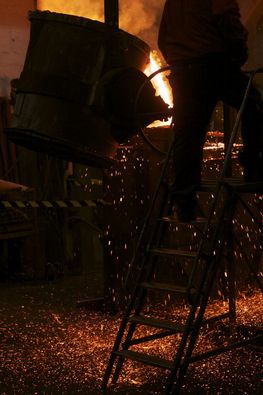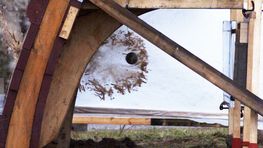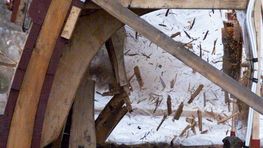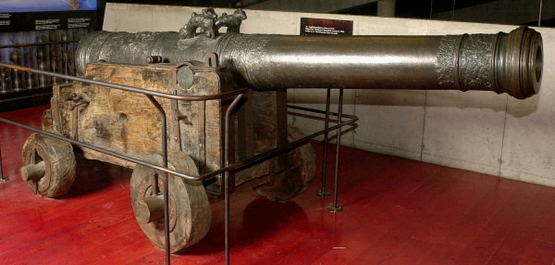Experimental firing trials with a reconstructed 17th-century cannon
Dr. Fred Hocker, Director of Research, Vasa Museum in Stockholm
In 2012-2014, the Vasa Museum test fired a common type of cannon developed in the 1620s; similar guns were used in the war of 1643-1644. The project investigated conventional ballistic properties, such as range, accuracy and effect, but also looked for data that would help us to understand the human experience of using heavy artillery on board warships.
The gun tested was a demi-cannon developed around 1620 for the Swedish army as mobile siege artillery, firing a solid iron ball weighing 24 pounds (9.96 kg). This was a new type of gun, shorter and lighter than the traditional 24-pounder. It was 2.85 m long and weighed about 1250 kg, around half of the weight of the gun it replaced, became a standard part of the Swedish army’s artillery train during the Thirty Years War. When King Gustav II Adolf ordered new multi-decked warships in the winter of 1624-1625, he decided that such guns could also be an effective way to increase the firepower of his navy, and ordered large numbers to be cast in the royal foundry in Stockholm. These guns were the main armament for the new ship Vasa, and followed with it to the bottom of Stockholm harbor when it sank on its maiden voyage in August 1628. Most of the guns were recovered and sold in the 1660s, but three 24-pounders were recovered with the ship in 1956-1961.
One of these guns was copied, cast in an alloy based on analysis of the original guns: 94% copper, 5% tin and 1% other metals, mostly lead and zinc. A new carriage and loading equipment were replicated, as well as ammunition representing all of the types found on the ship. Modern gunpowder was chosen, as it would be more consistent than a replicated historical powder and thus eliminate one variable from the analysis of the results. Modern powder is more powerful than the original, and so powder charges were reduced to bring the performance of the gun down to what can be extrapolated from 17th-century sources.
The gun was tested on the proving ranges at Bofors Test Center in Karlskoga, with full instrumentation to measure the velocity of the ball through the air and the pressure inside the gun, together with high-speed video. Sound levels were also measured, both in front of and behind the gun. Initial rounds were fired at a stone backstop to assess range and accuracy. During the second week, rounds were fired at an accurate full-scale reconstruction of a section of hull structure, representing Vasa’s side at the lower gundeck. Witness panels were placed inside the hull structure to measure the size and distribution of splinters created by rounds striking the hull.
A total of 54 rounds were fired, testing various combinations of powder and shot. Typical muzzle velocities were 300-360 m/sec (the speed of sound in air is 340 m/sec). At point-blank elevations, the gun has a range on flat ground of 800-100 meters, far in excess of the normal ranges at which ships engaged each other in this period. At 20 m, the shot form a group about 50 cm across; at 1000 m, the spread is about 20 m wide, which is well within the length of a typical warship (30-50m). This would suggest that accuracy is quite good, but in practice it would be hard to hit anything more than a few hundred yards away. At long range, a ship the size of Vasa covers an angle of elevation of only 0.2 degrees, which corresponds to a change in elevation of the muzzle of the gun of less than 1 mm, but a ship is not fixed but typically rolling through several degrees. There is also an inconsistent delay, often more than a second, between dropping the match into the priming powder to start the process of ignition and the firing of the main charge. The gunner thus has to time his actions in anticipation of where his ship will be in the roll, with no assurance that the charge will fire at exactly the right moment. The gun is thus far more accurate than the system of gun and ship together can be.
Shots through the replica hull showed that even a heavily built ship could not stop a 24-pound cannonball, and that conventional thinking about what happens when shot hits wood may not be correct. It was thought that thicker hulls were better defense against artillery, but the shock wave travelling ahead of a cannonball spreads out in the timber, so that the thicker the timber, the larger the splinters which spall off the interior. In our tests, a shot through 45 cm of solid oak produced large numbers of small (<10 g), high velocity (>300 m/sec) splinters. The majority of these did not have enough mass to penetrate clothing, let alone flesh. Cannonballs striking thicker parts of the hull, up to 90 cm thick, created much larger (>10 kg) splinters, still travelling at high speed (200 m/sec). These would be deadly. The counterintuitive conclusion is that if facing heavy artillery (18-pounders and larger), it might be a defensive advantage to be in a lightly built ship!




![[Translate to english:] Udstillingen 'I Røg og Brand' på Vikingeskibsmuseet](/frontend/Grafik/rog-og-brand-lille-side-banner-07.jpg)
![[Translate to english:] Udstillingen 'I Røg og Brand' på Vikingeskibsmuseet](/frontend/Grafik/rog-og-brand-lille-side-banner-04.jpg)
![[Translate to english:] Udstillingen 'I Røg og Brand' på Vikingeskibsmuseet](/frontend/Grafik/rog-og-brand-lille-side-banner-05.jpg)